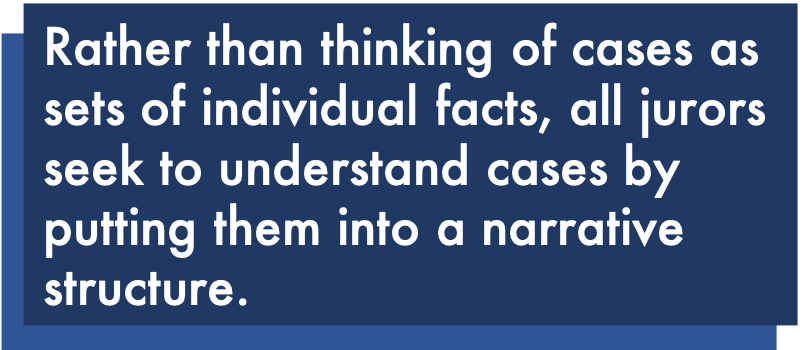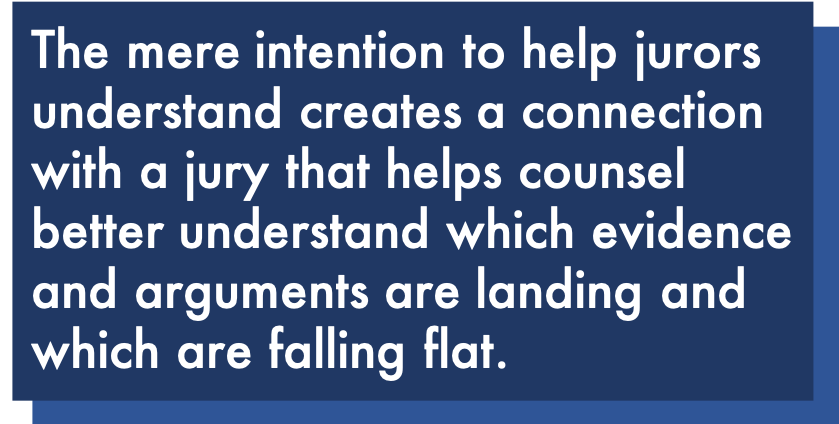“Much of the uncertainty of law is not an unfortunate accident: it is of immense social value.” — Judge Sonia Sotomayor
In a study of almost one thousand attorneys in 2016, conducted by the American Society of Trial Consultant Advisors and NYU Law School’s Civil Jury Project, uncertainty of jury decision making about damages, liability, and causation were three of the top six reasons given by lawyers about why they believe cases resolved without a jury trial. Mediators and trial judges also routinely caution parties about the unpredictability of juries when trying to negotiate (or pressure) a settlement in a given case.
But what are we really speaking about when we talk about trial predictability? Trial judges are not predictable regarding their rulings or their verdicts in a bench trial. Opposing parties are not predictable in their demands, their offers, or their decisions to settle or try cases. Arbitration decisions are not predictable. Sometimes, we tend to conflate predictability with familiarity. These days, with dwindling jury trials and increased use of mediation and arbitration, many attorneys are more familiar and comfortable with these forums where there is a common legal language.
In fact, jurors are no more unpredictable than judges or neutrals. Since all litigation involves human judgment, there are discreet cognitive components in a fact finder’s decision-making process, aside from evidence and law. And until we improve our skill in understanding these psychological components, we are not truly managing trial risk in our choices to settle or try cases. Understanding the qualitative elements that drive jury decisions make jury trials much more understandable, if not predictable.
So, what do we know about the research on legal decision making? Group decision making is more stable and more accurate than individual decision making.[1, 2] Larger groups (12 vs. 6 jurors) debate more vigorously, collectively recall more evidence from trial, and make more consistent and predictable decisions.[3] Research has also shown that larger juries are also more likely to contain members of minority groups, more accurately recall trial testimony, spend more time deliberating, and reach fewer erroneous decisions.[4] Judges, attorneys, and jurors all use the same process to evaluate cases—jurors are no more unpredictable than judges or attorneys as their decision-making patterns are more similar than they are different.[5] Also, judges are (for the most part) unable to ignore inadmissible evidence when making decisions—a judges’ decision-making process is just as susceptible to the same biases as jurors’ are.[6] This research confirms the wisdom of our forefathers in enacting the 6th and 7th Amendments to our Constitution. They knew that a group of citizens were more reliable, fair, and less prone to outside influence than a single arbiter.
Rather than thinking of jurors as unpredictable, it is more useful to try and understand the qualitative elements of jury (and judicial) decision making that we do not currently appreciate. If you understand the components and mechanism of a jury’s decision-making process, you come to understand that yes, juries are unpredictable, but in very predictable ways.
Much of lawyers’ misunderstanding about juror “unpredictability” stems from the fact that lawyers and jurors think differently. Lawyers train intensively for years in methods to critically analyze the facts and law in a given case. They then can spend months, if not years steeped in the factual and legal minutiae of a case, drafting motions, researching case law, talking with experts, conducting discovery, poring over documents, and making legal arguments. The amount of time and exertion on these legal and factual issues often take an outsized role in the estimation by litigation counsel of what is important to a jury. This is why conducting jury research can be so eye opening for lawyers and their clients as it can pinpoint the extra-legal factors that will influence the way jurors perceive and interpret the evidence and issues in a case.
Despite rehabilitation efforts in jury selection and the stern admonition to “set aside” their past experiences or beliefs, jurors cannot help but use, as reference material, their past experience as a driver in a car accident case, a patient in a medical malpractice case, or an employee in a workplace discrimination case. Similarly, strong beliefs about doctors or employers are not so easy to set aside. This is an example of confirmation bias[7] (which affects us all) where we search for and filter information which confirms what we already believe rather than keeping a truly open mind. Thorough and probing voir dire should be conducted to find out how, rather than whether or not a juror’s past experiences or beliefs will affect the way they listen to evidence. Additionally, research illustrates other factors that will make these “unpredictable” jurors more understandable. Authoritarian jurors are more likely to believe in retribution and punishment, thus vote guilty and seek to punish a defendant that is of lower social status.[8] Similarly, jurors who believe in a “just world” are more likely to blame the victim of a crime, believing that the victim must have done something to deserve what happened to them.[9] It is especially important in jury selection to pay attention to extraverted jurors as they are more likely to be selected as a foreperson, perceived as dominant by other jurors, and are more likely to be influential in deliberations.[10, 11]
Often, case presentations are structured around the litigant’s schedules rather than a jury’s comprehension needs. One of the elements that will make a jury’s verdict much more predictable is improving the clarity of each side’s case presentation. This is done by rigorously simplifying complex evidentiary and legal concepts, creating tutorials to give jurors context for the issues in a case, and creating compelling and evocative demonstrative exhibits to help jurors visualize the evidence. Asking for and allowing juror questions during the trial also helps litigants better understand how jurors are receiving the case, making their ultimate verdict much less unpredictable.
Rather than thinking of cases as sets of individual facts, all jurors seek to understand cases by putting them into a narrative structure.[12] By better understanding the nature of how jurors take evidence and put it into a story format, attorneys can better design their witness examinations, opening statements, and closing arguments. Research on the availability heuristic[13] tells us jurors will use what information comes easiest to mind. Thus, the more time, repetition, or emotional intensity that is placed on an issue in trial, the more jurors will think it is important. Knowing this will help attorneys better plan their case presentations, as well as direct and cross-examinations. In many cases, jurors are thrust into the world of building construction, doctors, scientists, engineers, and lawyers with little or no background knowledge. Norm theory tells us that jurors seek to understand the world they are asked to judge by seeking to establish the norm for that world.[14] Thus, it is important for attorneys to provide context or background for jurors about the world they are about to judge. Similarly, research on hindsight bias[15] tells us that jurors will always use today’s information to judge a party’s past behavior or actions. This is obviously important for attorneys who are dealing with “standard of care” issues in medical malpractice cases, “duty to warn” issues in product liability cases, and almost all personal injury cases involving an accident. Jurors are always tracking whether an accident or injury was foreseeable or preventable at the time by using what they currently know in the courtroom, knowing the outcome. Though this is not the legal standard, this is the natural inclination of jurors and attorneys ignore this bias at their own peril.
Additionally, attorneys often overestimate the resume credibility of experts or the factual testimony of witnesses and underestimate the demeanor and perceived attitude of the witness. Knowing how jurors actually evaluate witnesses’ character and credibility will greatly help attorneys to assess how their fact and expert witnesses are likely to be perceived by jurors. Fundamental attribution error[16] is another bias that explains how jurors overemphasize the personal characteristics of attorneys, witnesses, and parties when judging their behavior and decisions, while underemphasizing the external or situational factors that may influence those behaviors. For example, if a plaintiff or defendant makes a poor decision that is associated with an accident, that decision is more likely to be perceived as being a result of who that person is (e.g., “careless”, “arrogant”) rather than attributed to the circumstances of the accident. Research also tells us that jurors are more easily able to identify with an attractive defendant because they are perceived as having more likable qualities.[17] Similarly, ingroup/outgroup research[18] tells us that jurors more easily identify with someone they perceive to be a member of their own group, whether it be their race, religion, gender, social status, or sexual orientation. However, this identification can make a juror more sympathetic or more critical of the party or attorney in their group.
There are often issues outside of evidence that can strongly influence jurors. Without sensitivity and awareness of these issues, attorneys miss cues of behavior that can significantly impact the case. In a recent case involving a mother dying of a rare form of cancer she accused a doctor of failing to diagnose, she tearfully testified about not being around to see her young children grow up. During her cross-examination, the defense attorney in the case offered her water and questioned her with such compassion that jurors understood that the defense lawyer cared for this mother and her tragic situation, while still disputing her doctor client’s liability. In post-trial interviews, jurors offered how much they appreciated the attorney’s sensitivity, which influenced their defense verdict.
This highlights the importance of how a case is presented rather than just what is presented to a jury during a trial. Rather than thinking of the sole importance of evidence weight on a jury’s verdict, research supports that positive perceptions of an attorneys’ presentation of evidence and preparedness leads to more favorable outcomes for the attorneys, especially for prosecution and plaintiff attorneys.[19] For attorneys, their credibility is greatly enhanced by helping jurors to understand the case rather than just trying to forcefully persuade them that they are right. The mere intention to help jurors understand creates a connection with a jury that helps counsel better understand which evidence and arguments are landing and which are falling flat.
There are always two cases in a jury trial: the case the attorney wants to try and the case the jury wants to hear. By better understanding the elements of jury decision making, attorneys can reduce the unpredictability factor, improve their case risk evaluation, and increase the clarity and persuasiveness of their cases.
Richard Gabriel is President of Decision Analysis and Gabriela Cedré is an Associate Consultant with Decision Analysis, a trial consulting firm in Los Angeles. Mr. Gabriel is a former President of the American Society of Trial Consultants, author of the book Acquittal and co-author of Jury Selection: Strategy and Science.
Image used in this article: Storm clouds gathering via Flickr




Recent Comments